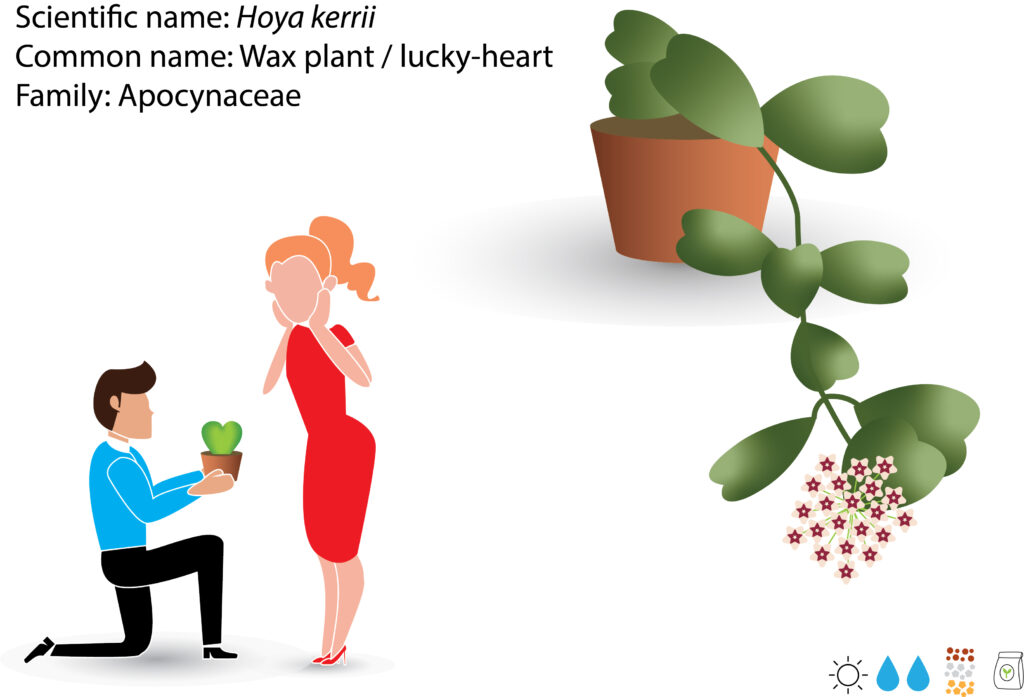A twiner or root climber with lovely leaves is known as Hoya under the family of Apocynaceae, with waxy foliage. It is one of the most popular plants that are about two to three hundred species during Valentine’s day that is native to Southeast Asia, New Guinea, and tropical Australia. Hoya is commonly known as a waxy flower that bears clusters of scented, star-shaped flowers in the summer. Hoya is waxy and resembles cake ornaments that have one star sitting atop a larger one.
There is a wax plant that is native to eastern India, southern Chine, and Burma, which is scientifically known as Hoya carnosa. It has dark green, glossy, oval leaves that can be grown against a small framework. It bears scented, star-shaped flowers that are white to pink in color together with the star that is dark pink located in the centers. Hoya carnosa ‘Compacta’ has twisted and upward leaves that look folded, which gave the plant a curious rope-like appearance. In addition, Hoya lanceolata subsp. Bella or Hoya bella is commonly known as a beautiful honey plat or miniature wax plant. This species is known as Himalayan that has arching stems with bright green, narrow, and lance-shaped leaves, which made it compact and shrubby. This miniature wax plant has white flowers with red or purplish-pink centers that hand in flattened clusters.
Furthermore, Hoya santos x cumingiana is one of the loveliest hybrids that having a cluster of sugared shooting stars like flowers. Each bloom has a small, reddish star that is attached to backward-pointing creamy beige petals. Moreover, Hoya serpens is a rather rare species from the Indian state of Sikkim with flowers that are covered with minute hairs to give a soft downy effect that is about half-inch wide. The most popular Hoya is Hoya kerrii that is native to southeast Asia that is originated from South China, Vietnam, Laos, Cambodia, Thailand, and Indonesia. It has thick leaves that are heart- or love-shaped, which is sometimes known as lucky-heart. It is sold for Saint Valentine’s Day in Europe. It can grow up to four meters high that have white color flowers with red to brown stars in the centers. The variegated Hoya kerrii would have leaves with white to yellowish white strips.
Hoya does well in any potting well-drain soil. It grows well in the condition with bright to very bright light with moderate temperatures and humidity. Water the soil only when the soil surface is quite dry. It is a slow-growing plant with a leaf that takes many months or years to root. Since it is a twiner or climber, it is slightly more likely to flower when it is supported on a frame and is also slightly pot bound. However, it may not do so for several years. It is best by avoiding pruning or picking the old spurs as the new flowers come from the same spurs. Hoya can be propagated from semi-ripe cuttings in the summer. The only note to take for placing the nice spot is to avoid an exposed area with mealybugs as the flowers produce sticky nectar drips that attract mealybugs. All hoyas look best when they are grown in a hanging pot or basket where the summer flowers can be admired.

Further readings:
William Grant Craib (1911). “Contributions to the Flora of Siam (continued)”. Bulletin of Miscellaneous Information. 1911: 385–474. pages 418–419
Villanueva, E. L. C., & Buot Jr, I. E. (2016). Hoyas of Mindoro Island, Philippines: Conservation Concerns. Journal of Nature Studies, 15(1), 87-97.